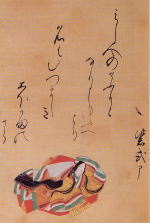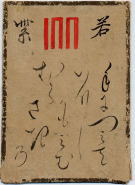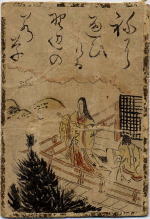|
||||||
A Thousand Years of The Tale of Genji My treasure `Genji Uta-Garuta`
'Murasaki' means 'purple' |
||||||
| Hello, everyone. It is already December, and I am worried if ever we could have snow this winter. It has been unusually warm here.How about your place? This month, I am going to talk about The Tale of Genji, because this year was the 1000th anniversary of this amazing literature. I am not a scholar, so I will not talk about the literature itself. I am going to show you something which is my treasure. It is a set of Genji Uta-Garuta. Do you know what is Uta? And what is Karuta? Ok, you can see these words below, from Wikipedia. First, Karuta, and then Uta. Uta is another word of Waka. Be careful, please. Karuta changes to Garuta when it is connected after another word like Uta. Karuta (かるた, Karuta?,
loaned from the Portuguese word meaning "card"
(carta)) is a Japanese card game.
The basic idea of any karuta game is to be able to quickly determine which card out of an array of cards is required and then to grab the card before it is grabbed by an opponent. There are various types of cards which can be used to play karuta. It is also possible to play this game using two standard decks of playing cards. There are two kinds of cards used in karuta. One kind is yomifuda (読札) or "reading cards", and the other is torifuda (取り札) or "grabbing cards." As they were denoted, the words in the yomifuda are read and players will have to find its associated torifuda before anybody else does. The two types of karuta cards that are most often seen are the "uta-garuta" and "iroha-garuta". In "uta-garuta", players try to find the last two lines of a tanka given the first three lines. It is often possible to identify a poem by its first one or two syllables. The poems for this game are taken from the Hyakunin Isshu and are traditionally played on New Year's Day. Anyone who can read hiragana can play "iroha-garuta" (いろはがるた). In this type, a typical torifuda features a drawing with a kana at one corner of the card. Its corresponding yomifuda features a proverb connected to the picture with the first syllable being the kana displayed on the torifuda. Karuta is often played by children at elementary school and junior high-school level during class, as an educational exercise. Although several kinds of Karuta games are described below, in reality any kind of information that can be represented in card form can be used - including shapes, colours, words in English, small pictures and the like. Waka (和歌) or Yamato uta is a genre of Japanese poetry. Waka literally means Japanese poem in Japanese. The word was originally coined during the Heian period to differentiate native poetry from the kanshi (漢詩 "Chinese poems") that were also familiar to all educated Japanese people. For this reason, the word waka originally encompassed a number of differing styles. The main two are tanka (短歌, lit. "short poem") and chōka (長歌, lit. "long poem"), but there are others: bussokusekika, sedōka (旋頭歌, lit. "whirling head poem") and katauta (片歌, lit. "poem fragment") . These last three forms, however, fell into disuse at the beginning of the Heian period, and chōka vanished soon afterwards. Thus, the term waka came in time to simply imply the one sub-form, tanka. Japanese poet and critic Masaoka Shiki created the term tanka in the early twentieth century for his statement that waka should be renewed and modernized. Until then, poems of this nature had been referred to as waka or simply uta ("song, poem"). Haiku is also a term of his invention, used for his revision of the old hokku form, with the same idea. For economy of thought, we will use here the term tanka for further description. Traditionally waka in general has had no concept of rhyme (indeed, certain arrangements of rhymes, even accidental, were considered dire faults in a poem), or even of line. Instead of lines, waka has the unit (連) and the phrase (句). (Units or phrases are often turned into lines when poetry is translated or transliterated into Western languages, however.) Thank you, WIKIPEDIA, for your kind explanation. Now, friends, I will tell the story of my treasure Karuta.
"?????" I wondered. "What is this poem? This is not any of the famous Ogura One hundred Poems by One Hundred Poets. I know each of the 100 poems. 100 poems karuta is very popular, even a school student knows it. But this poem......., ?????" The poem was vaguely familiar to me. I tried to remember the whole poem. Taxis passed by me, but I didn't move. After a long time, I remembered that this poem appeared in The Tale of Genji. I didn't even know that there existed Uta-garuta from the Tale of Genji. I was quite excited. I stepped into the shop, and saw an old man. "Hello, may I see the set of karuta in the window?" The old man murmured. "The Karuta is not a complete set. There must be 100, but they are only half." and he said, "Anyway I was going to throw them away, so you can have them cheap." This is how I got the Karuta "cheap". At home, I examined them very carefully and found that this was a perfect set of 54 poems, since The Tale of Genji is a union of 54 chapters.
I asked a friend of mine who was a professor of Japanese literature at Tokyo University, and he said this set of Genji Uta-Garuta was probably hand-made during the late Edo Period. More than 150 years old ! I was very happy to have this kind of important cultural antique. Since then, my treasure Karuta went to three exhibitions related to Genji, or Karuta. Do you think that I know all the poems appearing in the Tale of Genji? Never! I knew only one poem, and the card of that particular poem was on top of the cards on that day. Wasn't it a miracle? The poem appears in the Tale of Waka-murasaki (young purple). Waka-murasaki is the lady who was found by Hikaru Genji when she was just a child, and was grown by Hikaru Genji to become a perfect lady, and later she was made Hikaru Genji's most high ranked wife. Waka-murasaki was beautiful, kind-hearted, educated, and served best to Hikaru Genji. Waka-murasaki was a niece to a lady whom Hikaru Genji secretly loved. The poem above means that the Young Murasaki shares the same root with his prohibited lover Fujitusubo (Wisteria Lady). So I now believe, the sudden rain which stopped me on the day was Waka-murasaki's tears calling my help. Well, this is the end of a year, and I wish you a happy new year and a small miracle that makes you happy all life long! |
||||||
|
||||||



